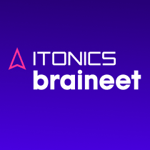The creative potential and collective intelligence of a company's employees, customers, and partners are some of the most valuable sources of innovation. Leveraged properly, these inputs can become significant drivers of change in your organization.
Based on our experience working with world-class innovation leaders across industries, the following article highlights the dos and don'ts, success factors, ideal setups, and best practices in building outstanding ideation challenges.
What is ideation
Ideation is a creative and systematic method for generating and refining valuable ideas in a multi-stage process consisting of phases and gates. While the number of ideas decreases over the course of the process, the depth and potential value of each idea increase. Organizations can involve employees, test users, clients, experts, service providers, or external crowds in their ideation process.

What is an ideation challenge
Ideation is about activating and pooling creative forces. It follows a systematic process to ensure that generated ideas are focused, aligned with company goals, and linked to decisive action. This is where ideation challenges come in. Depending on the context, ideation challenges are sometimes referred to as idea campaigns, co-creation workshops, or innovation contests.
Regardless of the name, ideation challenges are creative activities that involve a fixed or varying number of participants, contributors, and/or experts coming together to submit innovative ideas on a specific need or problem, followed by some form of collaborative evaluation to filter out the best winning ideas.
At their best, ideation challenges harness the collective intelligence of a diverse group to generate innovative solutions that deliver on specific sub-goals of an innovation strategy. Meanwhile, a poorly conceived and launched ideation challenge can waste time, discourage participants, and lead to stagnation.
How to run an ideation challenge
Step 1: Define the opportunity space
It is a common belief that the innovation journey starts with ideas. However, at ITONICS, we see it differently. Before beginning an ideation challenge, you should first be able to answer a basic but critical question: Where do we want to ideate, innovate, and grow?
"Where" represents the defined areas or opportunity spaces in which future growth is possible or perhaps even necessary. An opportunity space is, therefore, the starting point for any ideation process.
In an ideation challenge, the direction is usually established "top-down." Employees are invited to submit creative solution proposals for a particular problem defined by company leadership or strategy departments.
Clearly defining the scope and direction of your challenge from the outset improves the quality, relevance, and strategic alignment of submissions. By transparently communicating the intended goals of the ideation challenge, as well as a timeline and overview of the phase-gate process through which ideas will move, participants are likely to feel more engaged and accountable throughout the innovation process.
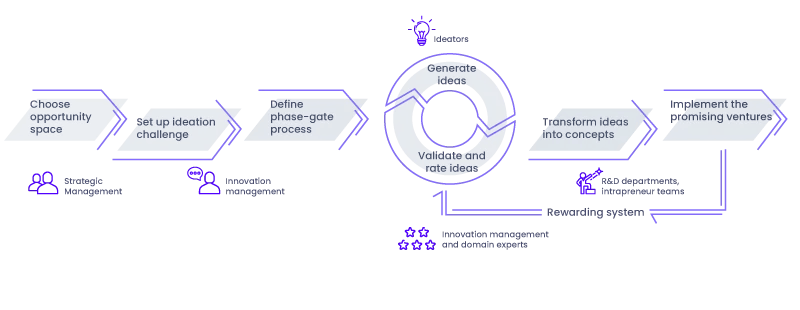 The bottom line: The best ideation challenges ensure harmony between the freedom of creative thinking and the right amount of clear processes and structures.
The bottom line: The best ideation challenges ensure harmony between the freedom of creative thinking and the right amount of clear processes and structures.
Step 2: Establish the structure
To establish the most effective structure for your ideation challenge, consider the following questions:
- Target group: Who is the challenge for?
- Phases and gates: What should the phase-gate process look like (e.g., inspire, ideate, review, and implement)? What are the activities and duration of each phase? What requisites must be met to proceed through each gate?
- Rating criteria: On what criteria will submitted ideas be rated (e.g., internal know-how, need for action, implementation risk)? Who is invited to rate ideas (e.g., subject-matter experts, cross-functional teams, and/or decision-makers)?
- Incentives: What levers or rewards can you utilize to motivate your target group to participate?
Top-down vs. bottom-up
There are two primary setups for ideation challenges: narrow (top-down) or broad (bottom-up). The narrow challenge focuses on solving a specific problem and can mean that more ideas will fall within a defined scope. At the same time, it can also limit participants’ creativity. A broader ideation approach is recommended to enhance knowledge exchange and generate a more diverse pool of ideas. Often accompanied by an always-open idea channel, the broad approach provides greater creative latitude and can result in a larger number of ideas spread across multiple topic areas.
Selected vs. broad group of participants
Another important consideration in designing your ideation challenge is the number and types of participants to include. Opening up your ideation challenge to everyone in your organization and/or all external stakeholders can produce more ideas. However, inviting a larger knowledge base to submit ideas does not automatically translate to better outcomes. With more participants, there is more complexity in managing the challenge and cutting through the noise to identify the most promising ideas. Depending on the scope and objectives of the ideation challenge—for instance, when a deep understanding of specific subject matters is required—inviting a select group of experts may be more effective than a broader audience.
Open vs. closed innovation
Creative communities are the key to innovation. They can engage and motivate crowds ranging from a few experts to thousands of idea contributors in global challenges. Whether you plan to engage a select group of experts or a large and global audience to participate in your ideation challenge, your organization can take either an open or closed approach to innovation.
In closed innovation, ideas are generated, developed, and commercialized internally, relying on internal resources, expertise, and capabilities. In contrast, open innovation actively seeks external ideas, knowledge, and technologies to complement internal capabilities. In the open innovation model, companies collaborate and engage with external partners, such as customers, suppliers, research institutions, startups, and even competitors, to co-create innovations.
The Bosch Open Innovation Partnerships platform is a successful example of open innovation. Another example is the Austrian motorcycle, bicycle, and sports car manufacturer KTM’s Become a Partner Gateway. These best practice examples of open innovation have led to new partnership opportunities, cost savings, and a greater depth of creative insights.
The bottom line: More participants or more creative freedom does not necessarily mean better results!
Activate collective intelligence with ITONICS Open Innovation
There are several jobs to be done along the innovation journey. Trend and technology scouts, subject-matter experts, lead and test users, customers, partners, and startups—they all play a role in providing diverse perspectives and valuable resources in innovation management.
With ITONICS Open Innovation, you can tap into the collective intelligence of a broad community. The approach promotes knowledge sharing and collaboration, which are core to fostering an innovation culture. Open Innovation is also a way to uncover potential partnerships and access new capabilities and expertise.
Step 3: Communicate your ideation challenge
Clear and transparent communication throughout the end-to-end ideation challenge is essential to success. It raises awareness, motivates participation, fosters collaboration, and aligns stakeholders. Best practices in communication include storytelling, a communication plan, and marking milestones.
Rely on storytelling. Label your challenge with a catchy title and a short description in which you explain to your participants the goals, requirements, dates, and deadlines. Include a concise call-to-action that makes it clear what is expected of the participants next. Underpin it all with information on relevant trends, target audiences, and real-life inspirations to add context and spark imagination.
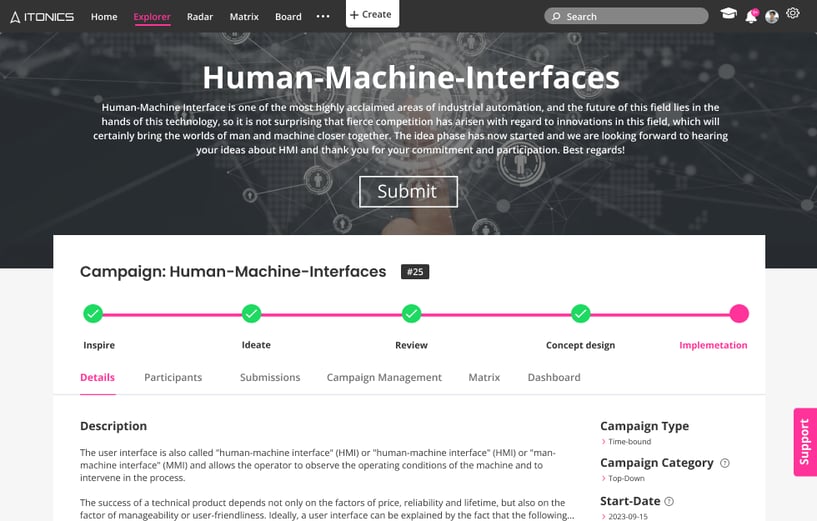
Develop a communication plan. A comprehensive communication plan ensures that all stakeholders are informed and involved at the right time. Different types of communication assets included in the plan serve different purposes:
- Informational mailings: Whenever a new ideation phase begins, be sure to inform the community about what will happen next and what is expected of them. Based on the roles and permissions defined for the campaign, you can differentiate the information you share with different groups of participants (e.g., contributors and evaluators).
- Reminder mailings: Toward the end of an ideation phase, remind participants of the action you want them to take (e.g., submit or rate ideas).
- Motivational mailings: If participation and engagement are lower than expected, try using incentives to motivate the community (e.g., through a bonus or scoring system).
- Online Discussion Forums: Setting up online discussion forums or social media groups dedicated to the challenge enables participants to interact, share ideas, seek feedback, and collaborate throughout the duration of the challenge.
Mark important milestones. Marking milestones throughout the challenge with virtual or in-person events enhances engagement while providing clarity and building a sense of community,
- Kick-off event: An actual kick-off event can have a much greater impact than a simple email. Secure management support and demonstrate that the ideation challenge is relevant and meaningful to the entire organization.
- Webinars and workshops: Hosting webinars and workshops at different stages of the challenge can provide participants with additional knowledge, skills, and insights. These sessions can be conducted by industry experts, mentors, or members of the organizing team, focusing on topics relevant to the challenge's theme.
- Awards ceremony: What better way to show appreciation than publicly recognizing the winners at the end of the challenge? Organize an awards ceremony where you introduce the winners and their projects, giving them the stage they deserve.
Step 4: Incentivize engagement
Building a compelling incentives scheme is a proven way to motivate a community to actively engage and contribute to an ideation challenge. Offering incentives demonstrates a commitment to valuing the contributions of all participants and fosters a sense of belonging and community.
Incentives can take various forms, catering to different motivations and preferences. Monetary rewards, such as cash prizes or bonuses, effectively recognize the tangible value of participants' contributions. However, non-monetary incentives can be equally compelling. Opportunities for skill development, mentorship, or career advancement resulting from idea implementation can inspire participation. Public recognition, both within the organization and industry-wide, can boost participants' reputations and increase additional awareness around the challenge.
Boost engagement with ITONICS gamification features
Gamification is a great way to encourage engagement by creating an environment that excites and motivates participants to contribute ideas. The ITONICS Innovation OS offers configurable gamification features, including a points system, badge rewards, and leaderboard to drive healthy competition.
Collaboratively rating submitted ideas also serves as a form of recognition and reward, giving participants a transparent view of where their ideas rank and on what criteria compared to others. A successful case study from one of our clients involves the development of a system that allows participants to bet on ideas by investing tokens in the projects they feel have the highest potential.
The bottom line: Incentives can take many forms, and the benefits go beyond boosting engagement; they also foster an innovation culture and community.
Step 5: Measure success
When success metrics focus immediately and solely on financial impact or vanity metrics, organizations can lose sight of the long-term goals and (not yet realized) value of innovation activities. Often, financial impacts are not felt in the short term, and vanity metrics like generated ideas or R&D spending also tend to focus on the current impact, neglecting possibilities in the future. Therefore, more appropriate indicators for monitoring, justifying, and steering innovation activities are actionable innovation metrics or key performance indicators (KPIs).
Actionable innovation KPIs must be relative (input/output) and time-bound to indicate actual progress. They should relate to specific strategic goals and reveal possible directions for change. For instance, rather than looking at the number of generated ideas in isolation, the number of generated ideas per number of participants over a defined time period provides more insight into the success of an ideation challenge. The purpose is to equip decision-makers with evidence of where innovation activities are headed if value is being delivered, and where changes are needed.
Having a central dashboard to visualize innovation KPIs streamlines reporting processes and helps stakeholders uncover insights and make informed decisions faster.
Ideation engagement KPIs:
Metrics that help to assess the motivation and participation of people to contribute to ideation challenges.
- % of community invited who submitted ideas
- # of submitted ideas
- # of contributors
- # of comments
- Likes
- Engagement rate
Ideation efficiency and effectiveness KPIs:
Metrics that help to assess how well ideas transform into innovations and whether the right ideas are selected.
- Time-to-innovation
- Idea-to-margin ratio
- Idea-to-innovation ratio
The bottom line: Use actionable innovation KPIs to measure the impact of your ideation challenge.
Ideation challenge dos and don’ts
The dos
Align with the innovation strategy. The success of your challenge depends heavily on clearly communicated goals, timelines, and processes that align with the company's overall innovation strategy.
Invite the right people. Ideation challenges are usually not about mass ideation. Try to target your high-caliber idea generators and subject-matter experts with appropriate topics to drive ideas to their maximum potential. Including participants with different backgrounds, professions, and hierarchy levels can also increase creativity and reduce bias.
Communicate frequently and transparently. It's important for challenge participants to get feedback: Why should I engage? What is the status of my idea? What are the next steps in the challenge? What is the duration of the challenge? How will the ideas be evaluated? By whom? What are the winning ideas?
Ensure a win-win situation. Increase awareness and participation by rewarding everyone who submits an idea. Participants invest time and effort in formulating their ideas, and acknowledging these contributions can help boost motivation and future engagement.
Connect ideas to action to incentivize participants. Participants are more motivated when they know that ideas from the challenge will actually be implemented. Communicate the steps to get there—for instance, presenting the top ideas to senior management, building business cases, and allocating resources to bring ideas to life.
Create a global go-to space. Great ideas can emerge from anyone at any time. Whether in a targeted and time-bound challenge or a bottom-up, always-open idea channel, it is crucial to have a digital collaborative platform to capture, structure, evaluate, and prioritize these ideas.
Move ideas to execution with ITONICS Campaigns
Generating ideas is one thing, but for many organizations, the difficulty lies in connecting these ideas to action, prioritizing what to execute, and doing so quickly and at scale. A phase-gate process is a proven method for ensuring good ideas are not missed, under-resourced, or matched with the wrong teams for implementation.
ITONICS Campaigns is idea management software for launching, monitoring, and mobilizing ideation challenges. With workflows in ITONICS, you can configure custom idea phase-gate processes, automate tasks, strengthen oversight, and ensure the efficient execution of your most promising ideas.
Get dedicated idea managers on board. Assign an individual or group of users to act as neutral facilitators, providing updates and support to all stakeholders within the challenge. Their role is to communicate with these stakeholders and ensure that the guidelines and process set out for the challenge are followed.
Involve affected departments. Make sure to involve the business units affected by the ideation challenge at an appropriate time. They can provide valuable perspectives and recommendations on the feasibility of the challenge topic.
The bottom line: Always promote the quality of ideas, not the quantity!
The don'ts
Unfair competition. Changing the structure or process of the challenge—without properly communicating the changes in advance—can result in advantages or disadvantages for different user groups, even if unintentionally. For instance, changing evaluation criteria, permissions, or the submission window during an active challenge should be avoided.
Restricting the creativity and control of participants. Ideation challenges should always preserve the freedom of creativity and encourage voluntary contribution. It is important to acknnowledg all contributions, even misaligned or unfeasible ideas, and participants should retain the autonomy to discard their ideas if they choose.
Create overly complex, lengthy processes. More phases and gates do not necessarily make an ideation challenge more successful. Each step should serve a clear purpose and involve specific activities and outcomes. Ensure participants know where in the process their idea is—avoid allowing ideas to simply fizzle out.
Collect ideas "along the way." An unstructured approach with face-to-face brainstorming sessions, emails, Excel spreadsheets, or suggestion boxes with no clear goal may generate some buzz and ideas. However, these approaches are difficult to connect to action and transfer into strategic innovation projects.
The bottom line: Fair competition and clearly defined rules are foundational for successful ideation challenges.
Best practice ideation: The Cisco Innovate Everywhere Challenge
Cisco launched its first company-wide Innovate Everywhere Challenge. The aim was to drive global disruptive thinking, capture game-changing innovation opportunities from Cisco employees, and enhance employee experience, empowerment, and collaboration across all functions. These objectives were summed up in the message: "Team up, Disrupt, and Innovate."
By effectively defining and structuring the ideation challenge in the ITONICS Innovation OS, Cisco was able to engage half of its workforce, around 36,600 employees, and generate around 770 innovative ideas.
Using a collaborative platform, we were able to implement the Innovate Everywhere Challenge as an integral part of our innovation management and engage a worldwide community to team up and innovate together. We achieved a Cisco-wide cultural change and created an interconnected network of innovators.
– Alex Goryachev, Director of Innovation Strategy, Cisco
Cisco established the Innovate Everywhere Challenge as a vehicle to shape its future growth. Supported by the ITONICS Innovation OS, Cisco could easily scale this challenge throughout its organization and, in doing so, establish a best practice for idea management, and innovation management in general, going forward.
Get a free demo to learn more about why and how Cisco and other global leaders in innovation use the ITONICS Innovation OS to achieve their innovation goals. Elevate your ideation challenges and systematically transform your most promising ideas into valuable innovations—all in one collaborative platform.
Your digital platform to collect, evaluate, and implement ideas
The ITONICS Innovation OS provides an end-to-end idea management software solution that allows you to manage ideas from inception to execution. With ITONICS Campaigns, you can define custom idea workflows and evaluation criteria. ITONICS Open Innovation enables you to involve clients, external experts, startups, and potential partners in generating solutions for short-, mid-, and long-term challenges.
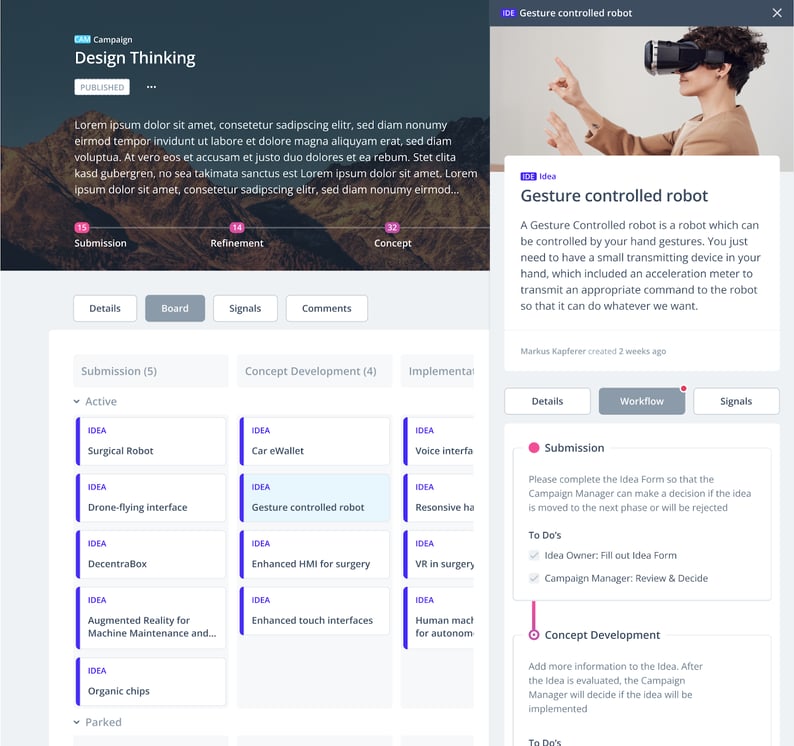
Features like KPI and activity dashboards, interactive visualizations, and analytical tools allow you to monitor and rank ideas. Encourage participation with gamification, nudging, and customized submission platforms. Establish roles and permissions, operate within a clearly defined governance framework, and build the transparency and structure needed to drive innovation in your organization.
ITONICS is much more than just idea management software. It anchors ideation in a single point of truth to bring ideas to life faster. Unlike fragmented idea management software solutions, it links your ideation activities to foresight intelligence and portfolio to maximize your innovation potential and deliver on your strategic goals with speed and agility.
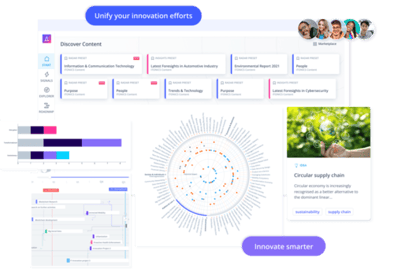
See the ITONICS Innovation OS in action





